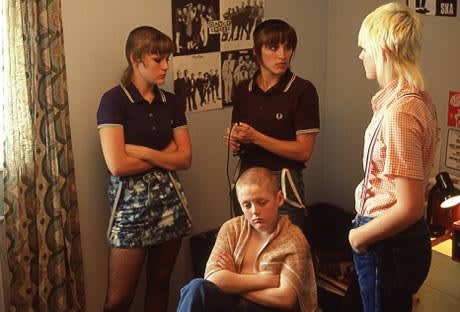In 1983, England was a miserable place to call home. Although it gave Morrissey something to mope about, the morale of the country was under the vice-like grip of Thatcherisms "popular capitalism. It was also an era where skinheads, or "suedeheads, as Moz would immortalise in his music, were as fashionable as ever, be it through ties with the hateful National Front or in the very opposition via anti-racist gangs.
Shane Meadows This Is England paints a portrait as such, using montages to open and close the film, as well as an ambiguous working class setting as the canvas for his seventh feature. Interestingly, Meadows, who also wrote the film, uses a 12-year-old outcast as the storys powerful anchor. Living with his widowed mother, Shaun (Thomas Turgoose) is a misguided kid who doesnt fit in anywhere, until one day a group of harmless skins take a peculiar interest in him. They groom and dress him as one of their own but more importantly, treat him with respect and adopt him as their newest brother.
When pseudo-leader Combo (Stephen Graham) is released from prison, he arrives with a new outlook on societal problems. He rubs Milky, the groups only member of colour, the wrong way and quickly creates a divide, leaving some to stay and some to go. Deciding to stay with the rough but fatherly Combo, Shaun quickly finds himself attending a National Front meeting and witnesses an ugly side to his newfound family that ends in an unwarranted act of hateful violence.
Mirroring 1982s Made in Britain, which gave a similar "of the moment illustration, This Is England is very much a sign of modern times, especially in a country thats still struggling to accept the ongoing influx of immigrants. The underlying themes of poverty and gang culture ring true anywhere in the world though, and Meadows juxtaposition of political drama with a coming of age story will resonate with just about any viewer.
(Alliance Films)Shane Meadows This Is England paints a portrait as such, using montages to open and close the film, as well as an ambiguous working class setting as the canvas for his seventh feature. Interestingly, Meadows, who also wrote the film, uses a 12-year-old outcast as the storys powerful anchor. Living with his widowed mother, Shaun (Thomas Turgoose) is a misguided kid who doesnt fit in anywhere, until one day a group of harmless skins take a peculiar interest in him. They groom and dress him as one of their own but more importantly, treat him with respect and adopt him as their newest brother.
When pseudo-leader Combo (Stephen Graham) is released from prison, he arrives with a new outlook on societal problems. He rubs Milky, the groups only member of colour, the wrong way and quickly creates a divide, leaving some to stay and some to go. Deciding to stay with the rough but fatherly Combo, Shaun quickly finds himself attending a National Front meeting and witnesses an ugly side to his newfound family that ends in an unwarranted act of hateful violence.
Mirroring 1982s Made in Britain, which gave a similar "of the moment illustration, This Is England is very much a sign of modern times, especially in a country thats still struggling to accept the ongoing influx of immigrants. The underlying themes of poverty and gang culture ring true anywhere in the world though, and Meadows juxtaposition of political drama with a coming of age story will resonate with just about any viewer.
